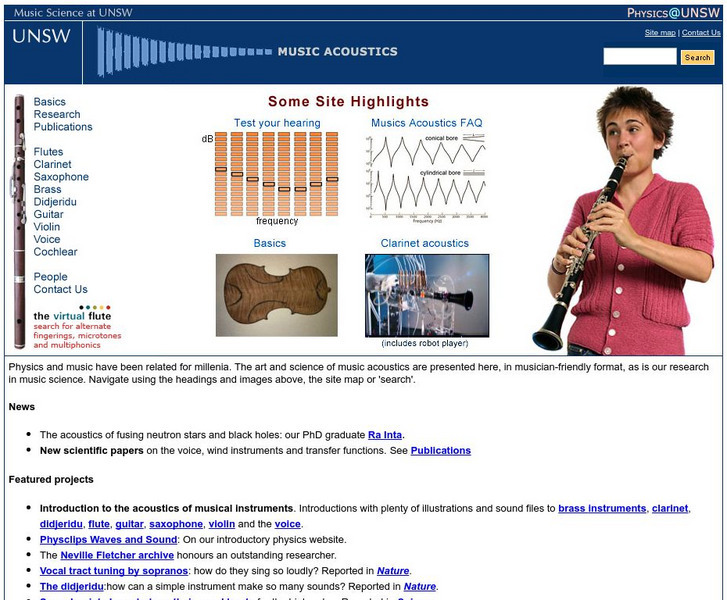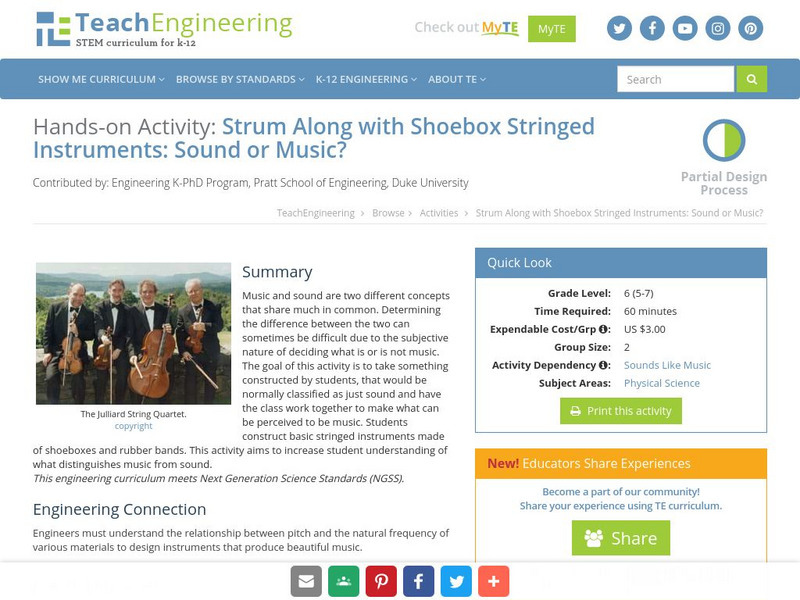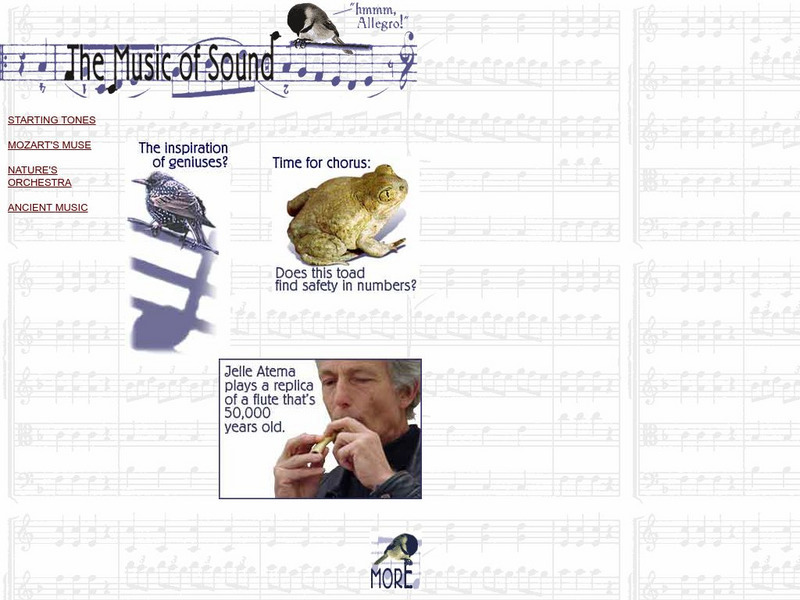Exploratorium
Exploratorium: Science of Music: Accidental Scientist
Learning about the science of music is what this site is all about. With clever activities that lead to writing, mixing, and experimenting with music; with videos that explain tuning, stepping (or rhythmic movement), instrument building,...
University of New South Wales (Australia)
University of New South Wales: Music Acoustics
Learn about the science of music acoustics. Topics such as how do violins change with age and brass acoustics are explored through scientific research.
University of New South Wales (Australia)
University of New South Wales: Introduction to Acoustics of Brass Instruments
Discover the acoustical properties of brass instruments from this well researched site provided by the University of New South Wales. Everything from lip control to bell shape is discussed as it applies to frequencies and harmonics.
University of New South Wales (Australia)
University of New South Wales: Introduction to Flute Acoustics
Explore the physics of sound production of a flute. How do things like tone holes and register holes effect the acoustics of a flute? Learn more about that and more at this well researched site.
University of New South Wales (Australia)
University of New South Wales: Introduction to Saxophone Acoustics
Learn all about the ways a saxophone produces sound. Discover why the reed, playing softly or loudly and tone holes play important roles in this instruments acoustics.
University of New South Wales (Australia)
University of New South Wales: Introduction to Clarinet Acoustics
Learn about how the acoustics of a clarinet work by exploring this well researched site. You'll learn about the frequencies, the effects of the reed, the tone holes and more.
Washington State University
Washington State University: Ask Dr. Universe: Why Do Musicians Use Both Sides of Their Brains?
Website using a question-answer format in which Dr. Universe attempts to answer a curious question a student has about why musicians use both sides of their brains.
TeachEngineering
Teach Engineering: Strum Along
Music and sound are two different concepts that share much in common. Determining the difference between the two can sometimes be difficult due to the subjective nature of deciding what is or is not music. The goal of this activity is to...
TeachEngineering
Teach Engineering: Making Music
In this instructional activity, learners learn about sound. Girls and boys are introduced to the concept of frequency and how it applies to musical sounds.
TeachEngineering
Teach Engineering: Energy Transfer in Musical Instruments
This lesson plan covers concepts of energy and energy transfer utilizing energy transfer in musical instruments as an example. More specifically, the lesson plan explains the two different ways in which energy can be transferred between...
PBS
Pbs: Nature: Song of the Earth With David Attenborough
Explore the sounds of nature and how they connect with music. Investigates what purpose music serves through nature and what it means.
University of Wisconsin
The Why Files: The Music of Sound
This resource from the University of Wisconsin explores the relationship between music and science by exploring bird songs, Mozart, alligator and penguin sounds to name but a few.
Other
Physics and Psychophysics of Music
This site is filled with information pertaining to the physics of sound and music.
TeachEngineering
Teach Engineering: Simple Instruments
In this activity, students work with partners to create four different instruments to investigate the frequency of the sounds they make. Students may chose to make a shoebox guitar, water glass xylophone, straw panpipe or a soda bottle...
OpenStax
Open Stax: Catherine Schmidt Jones: Sound and Music
Introduce some activities that introduce students to the physics of sound. They will also learn how various instruments produce sound. Included are downloadable pdf worksheets and answer sheets to use.
Rock and Roll Hall of Fame
Rock & Roll Hall of Fame: Sti Lesson 11: The Cigar Box Guitar
Science instruction is most effective when using a hands-on delivery system. This lesson plan will use your young scholars' natural affinity for music and musical instruments to reinforce and refine their knowledge of the nature of sound...
ArtsNow
Arts Now Learning: Exploring Habitats Through Music Composition [Pdf]
In this lesson, young scholars will learn about rondo form and practice a chant. After learning about the structure of the chant, they will work in small groups to create a chant about a habitat. The chants will then be combined with the...
New York Times
New York Times: Simulating the Masters
This site scientifically explains how 18th century master violin makers produced such beautiful sounds with their instruments. The use of animated graphics and brief explanations allow the viewer to understand how scientists are trying...
Arizona State University
Arizona State University: Water
This online lesson from the Arizona State University teaches students about earth's water cycle yet uses music as a part of the instructional process. Creative and simple. Non-music specialist could easily use the lesson.


















